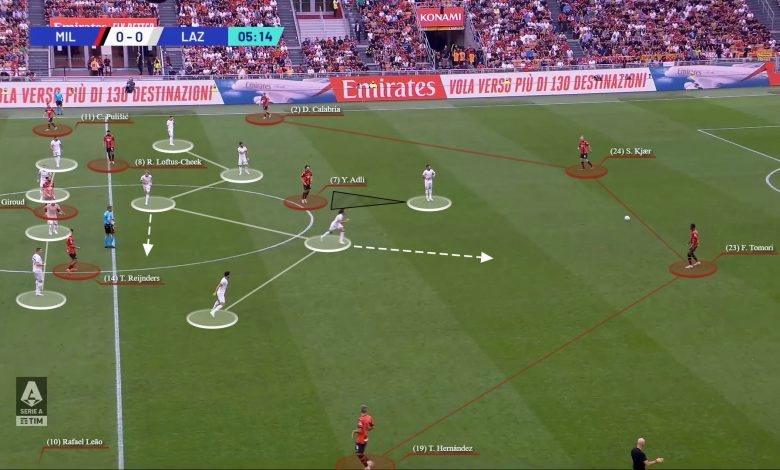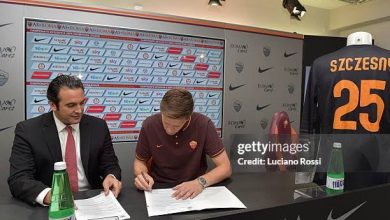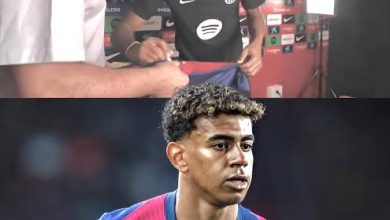Off-ball approach holds the key: Tactical analysis of AC Milan 2-0 Lazio

AC Milan beat Lazio 2-0 at San Siro on Saturday evening for their third win on the spin in Serie A, meaning they have recovered from the derby loss in the ideal way.
In the opening 45 minutes, both team’s defensive gameplans were having the biggest impact upon the match. With neither side able to breakdown the other in settled possession, trying to exploit in transitional moments was proving the biggest threat for each.
Whilst Lazio were leading on the shot count come the interval, the majority of their efforts were from distance. The visitors best chance came courtesy of a Simon Kjær misread which enabled Felipe Anderson to carry the ball into the box before shooting into the side netting in the 13th minute.
For Milan, despite having the majority of the ball, they struggled to convert their possession into attempts on goal in the first-half.
On the stroke of half-time, however, after a low Yunus Musah cross from the right wing and a Oliver Giroud shot forced Ivan Provedel to parry, Tijjani Reijnders pounced but could only sort his feet enough to hit the outside of the post after rounding the goalkeeper.
In the second-half, after a visible increase in intensity from Milan without the ball, the home side took control of the game in all phases and got their breakthrough in the 60th minute when Christian Pulisic fired in a Rafael Leão cutback.
After this opening goal, Milan were content to protect their lead and counterattack. This therefore afforded Lazio more possession but the away side were predominantly limited to shooting from distance.
Milan wrapped up the victory in the 88th minute when they played out from a goal kick and down the left wing before another Leão cutback was converted by substitute Noah Okafor.
In what was a deserved win, even Arrigo Sacchi stated in his post-match analysis that Milan’s second-half performance: “…bordered on perfection. An organized, aggressive team, where everyone helped each other.”
Equally impressed was @Tactics_Tweets who has taken a closer look at how both team’s out of possession set-ups impacted the game.
Set-ups
Stefano Pioli continued to make changes to his starting line-up due to fixture congestion. Coming back into the side were Mike Maignan, Davide Calabria, Simon Kjær, Olivier Giroud and Rafael Leão.
In possession, Milan maintained their 4-3-3 shape with both full-backs maintaining their width in build-up phases. Without the ball, the home side used a 4-2-3-1 system which enabled them to go player-for-player in central midfield.
For Lazio, Maurizio Sarri made three changes to his side which beat Torino in midweek. With the ball, the visitors formed their usual 4-3-3 shape and without, they dropped into a compact 4-5-1 mid and low block.
Lazio’s mid-block
Despite Lazio’s lower line of engagement, they were not passive out of possession.
The visitors implemented a specific pressing scheme from their mid-block which involved the ball-sided midfield 8 (either Mattéo Guendouzi or Luis Alberto) jumping out to engage the Milan backline when on the ball. Nicolò Rovella would then shift across in behind to cover the vacated space and Valentín Castellanos aimed to use his cover shadow to block passess into Yacine Adli.
The screengrab below was a common sight in the first-half – Milan in possession in their 4-1 base structure, with their two midfield 8s advanced, and Lazio in their compact 4-5-1.
With Lazio’s compact mid-block blocking central areas of the pitch, the majority of Milan’s play involved trying to progress the ball down the flanks (around the block) or in behind (over the block).
However, often in the time it took Milan to enter the final third, Lazio had been able to drop into their low block shape, limited space and access into the penalty area.
In build-up phases. their full-backs maintained in an attempt to stretch the opposition, allow for easier ball circulation and retention around their backline, and create overloads on the flanks.
In addition to this, Milan also tried to disjoint the Lazio defensive structure with timed opposite movements, particularly by Giroud (coming short) and Reijnders (depth run). The idea being this could either create space for Giroud in between the lines or Reijnders could be found in behind.
In this sequence below, you can see the difficulty Lazio’s mid-block caused Milan. We start with the recurring scene of Milan’s 4-1 base structure and two advanced midfield 8s nearer the forward line, against Lazio’s 4-5-1..
Milan’s out of possession approach was equally effective and in the second-half helped make the difference in swinging the momentum in their favour.
Milan’s midfield man-marking
Without the ball, Milan organised themselves into a 4-2-3-1 formation which helped them match-up to Lazio’s 4-3-3 in possession shape.
This was most apparent in central midfield where Milan’s midfield three could go player-for-player against Lazio’s midfield three. Reijnders pushed highest to get near Rovella, and this left Adli to cover Guendouzi and then Ruben Loftus-Cheek (and subsequently Musah) on Luis Alberto.
Milan were prepared to be -1 in their forward line (Pulisic, Giroud and Leão) versus the Lazio back four, as this allowed them to maintain a +1 in their backline (back four) against the Lazio three forwards.
This +1 in the back four resulted in one of the Milan central defenders predominantly being spare at the back and able to provide coverage where needed, with both full-backs able to track the wide Lazio forwards.
The trade-off of this numerical superiority in their backline was their forward line being a player short. Milan therefore relied upon Giroud splitting the two Lazio central defenders (i.e. preventing passes in between them) or the wide forward vacating a full-back to press inside (more on this shortly).
This out of possession approach from Milan had a similar outcome to Lazio’s in that it helped force the away side into looking at alternate progression routes, as opposed to central ones.
By ensuring Lazio’s central midfielders were all covered by a Milan player, this reduced the visitors backline’s access (and risk factor) of passes into their midfield.
Like Milan, Lazio were therefore restricted in their possession play, as can be seen in the 2nd minute of the game.
Lazio had a freekick which enabled Milan to get into their 4-2-3-1 formation. Giroud blocked the passing lane to the far-side central defender which enabled Pulisic and Leão to cover the opposition full-backs. Then, in central areas, the Milan midfielders are each in close proximity to their respective responsibility.
With central progression both difficult and risky to access, Lazio attempted to progress the ball down the left flank.
Below, you can now see the advantages the +1 in the Milan backline affords them with Calabria able to stay tight to the Lazio left winger (preventing him from turning), Kjær covering the central striker who had drifted over towards the ball-side and Tomori providing coverage.





